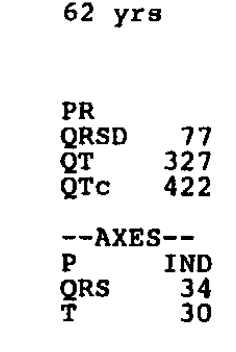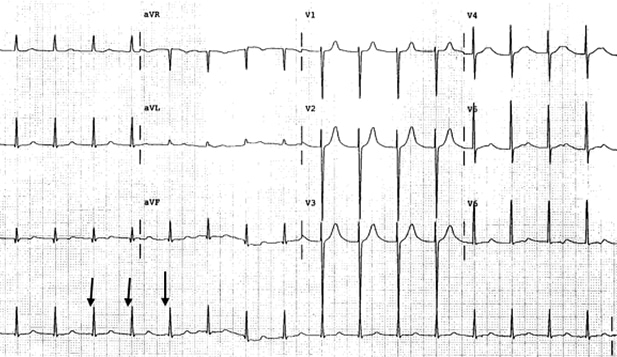Published on
Differential Diagnosis
- First-degree AB block
- Normal sinus rhythm
- Atrial flutter
- Junctional rhythm
- Wenckebach type 1


Diagnosis
This patient was diagnosed with junctional rhythm.
The ECG reveals a regular rate. There are no P waves, making first-degree AV block impossible. The rhythm is regular, so this is not atrial fibrillation. Wenckeback type 1 has a gradual lengthening of the PR interval until there is a dropped beat (a P without a QRS following) and is not occurring in this ECG. Normal sinus rhythm would require a P wave before each QRS. There are no P waves evident on the tracing; this ECG shows a junctional rhythm.
Learnings/What to Look for
- Junctional rhythm has the depolarization initiated at the cardiac junction, at the AV node; as there is no atrial depolarization, there are no P waves
- The rate is typically slow, between 40 and 60 beats per minute. As the depolarization is initiated above the ventricles, it results in a narrow QRS complex
- Junctional rhythms may occur in patients with sick sinus syndrome (SSS) or simply with significant bradycardia
- Patients with junctional rhythm do not have an increased morbidity or mortality (unless the underlying cause, such as SSS, would result in a changed morbidity or mortality)
Pearls for Urgent Care Management and Considerations for Transfer
- Inquire about signs of ischemia such as chest discomfort, shortness of breath, diaphoresis, or dizziness, as well as hemodynamic instability such as hypotension, dizziness, or confusion
- Compare to an old ECG to see if the rhythm is new or an incidental finding
- Consider checking electrolytes in patients who may have abnormalities, such as patients on diuretics or those with renal failure
- If the patient is asymptomatic and the rhythm is found incidentally, inform the patient of the rhythm, but no further urgent care management is necessary, and the patient may follow up as an outpatient with primary care.
A 62-Year-Old Woman with Palpitations
1 2
